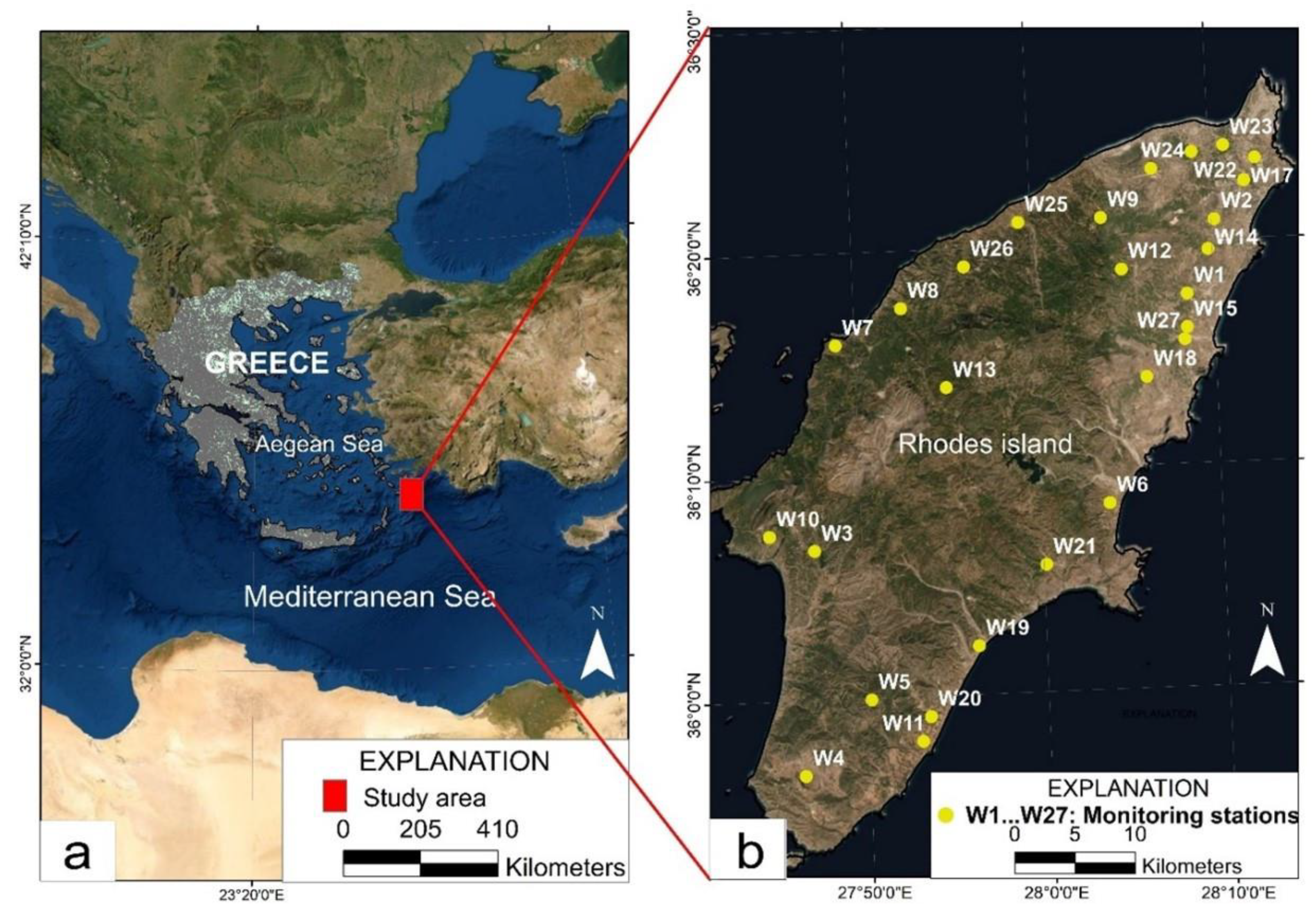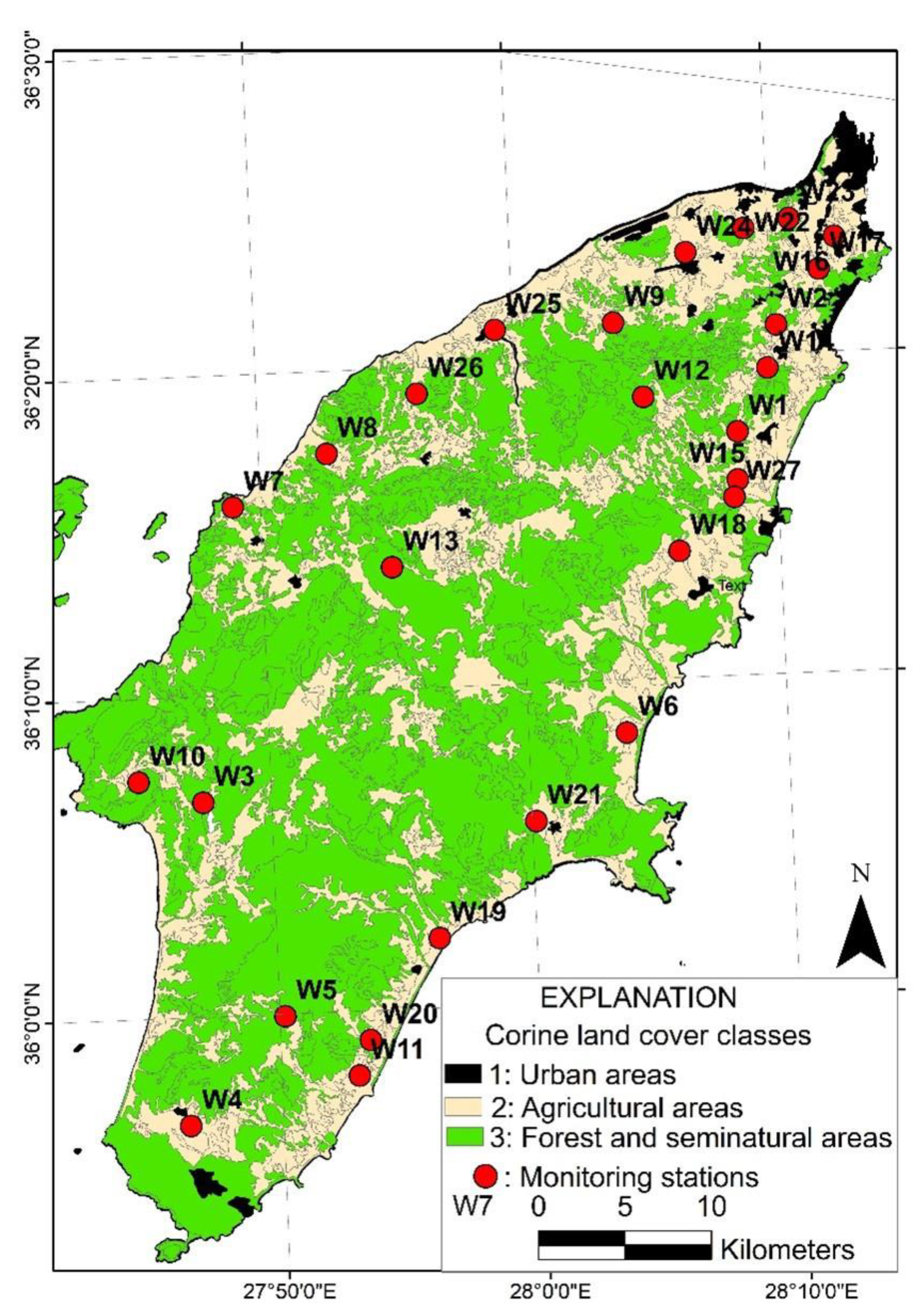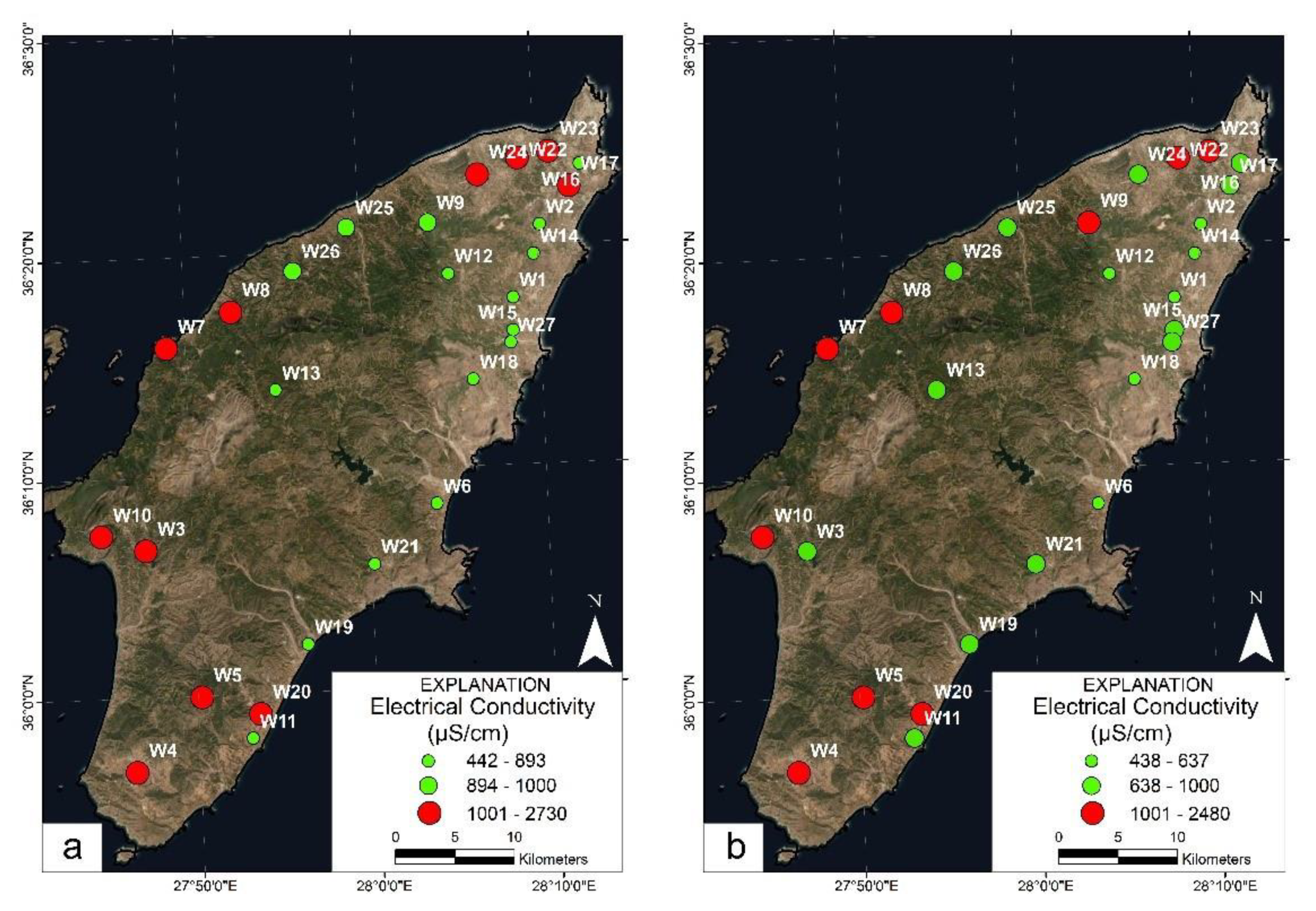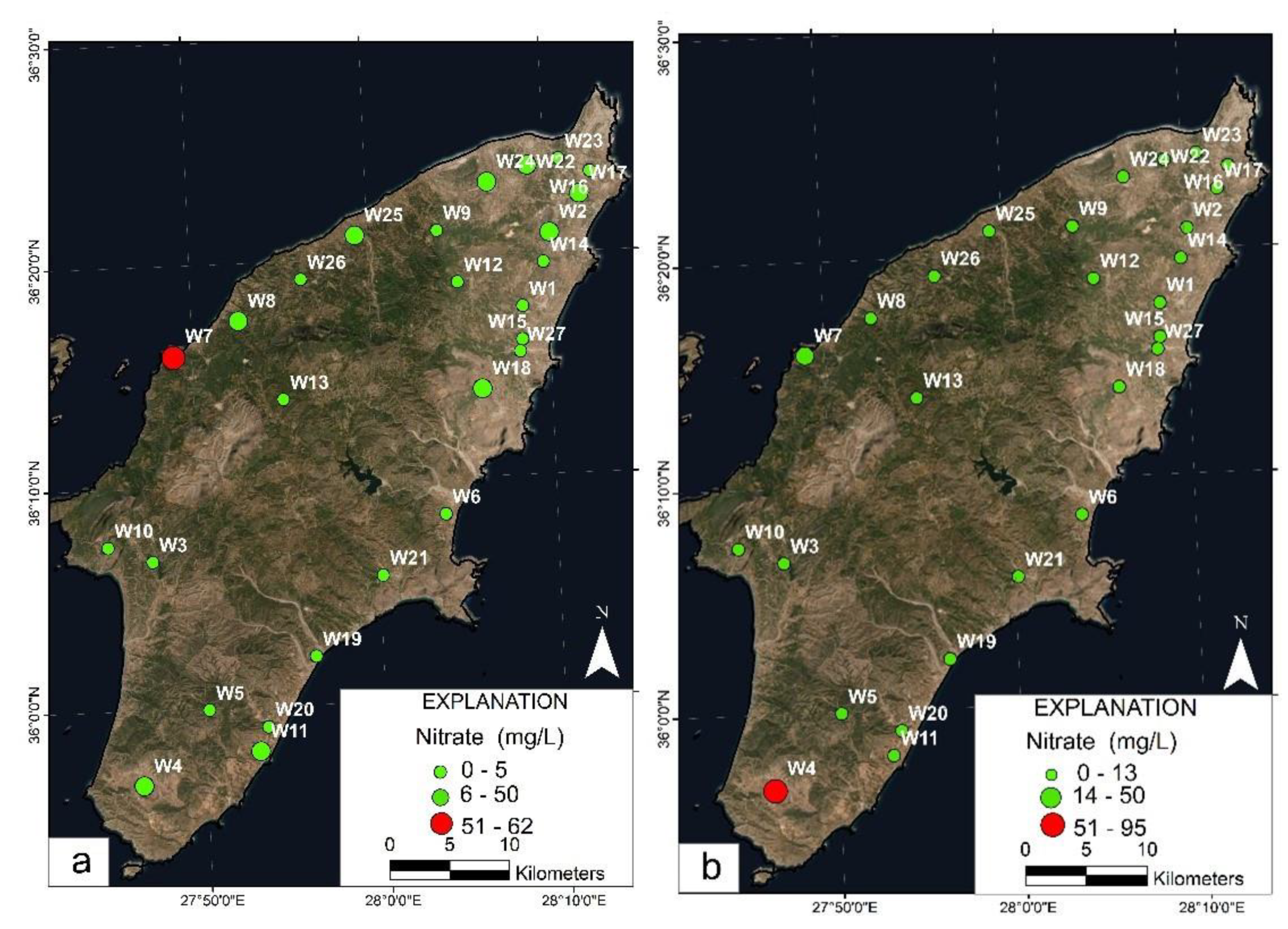Applying Factor Analysis and the CCME Water Quality Index for Assessing Groundwater Quality of an Aegean Island (Rhodes, Greece)
Abstract
:1. Introduction
- (a)
- Alexakis [1] proposed a new meta-evaluation approach of two widely used WQIs for application in groundwater quality assessment;
- (b)
- Panagopoulos et al. [17] implemented the CCME-WQI (Canadian Council of Ministers of Environment Water Quality Index) for the evaluation of the physicochemical quality of Greek rivers;
- (c)
- Alqarawy et al. [18] combined, among others, physicochemical parameters and WQIs to delineate water quality and controlling factors using multivariate modeling techniques;
- (d)
- Haider et al. [19] discussed the spatiotemporal water quality variations in smaller water supply systems by applying modified CCME-WQI from groundwater resources to distribution networks;
- (e)
- Molekoa et al. [20] employed hydrogeochemical analysis of groundwater samples to calculate WQI and evaluated factors governing water quality evolution in the Mokopane area (South Africa);
- (f)
- Shafique et al. [21] applied multivariate and geospatial monitoring of water and soil quality to investigate the impact on the planted mangroves growth pattern at the Indus delta;
- (g)
- Aldrees et al. [22] presented the development of a multi-expression programming based predictive model for water quality parameters and WQI.
2. Materials and Methods
2.1. Study Area

2.2. Primary Data and Data Treatment
2.3. Application of WQI
3. Results and Discussion
4. Conclusions
Funding
Data Availability Statement
Acknowledgments
Conflicts of Interest
References
- Alexakis, D.E. Meta-Evaluation of Water Quality Indices. Application into Groundwater Resources. Water 2020, 12, 1890. [Google Scholar] [CrossRef]
- Alexakis, D.E. Water Quality Indices: Current and Future Trends in Evaluating Contamination of Groundwater Resources. Water 2021, 13, 401. [Google Scholar] [CrossRef]
- Alexakis, D.E. Linking DPSIR Model and Water Quality Indices to Achieve Sustainable Development Goals in Groundwater Resources. Hydrology 2021, 8, 90. [Google Scholar] [CrossRef]
- Alexakis, D.E. The Relationship between the Chemical Composition of Groundwater and the Geological Environment in the East Attiki Area, Greece. Miner. Wealth 1998, 109, 12. [Google Scholar]
- Alexakis, D.; Tsihrintzis, V.A.; Tsakiris, G.; Gikas, G.D. Suitability of Water Quality Indices for Application in Lakes in the Mediterranean. Water Resour. Manag. 2016, 30, 1621–1633. [Google Scholar] [CrossRef]
- Lalumbe, L.; Kanyerere, T. Characterisation of Hydro-Geochemical Processes Influencing Groundwater Quality in Rural Areas: A Case Study of Soutpansberg Region, Limpopo Province, South Africa. Water 2022, 14, 1972. [Google Scholar] [CrossRef]
- Bakalár, T.; Pavolová, H.; Tokarčík, A. Analysis and Model of River Basin Sustainable Management by SWOT and AHP Methods. Water 2021, 13, 2427. [Google Scholar] [CrossRef]
- Feng, J.; Sun, H.; He, M.; Gao, Z.; Liu, J.; Wu, X.; An, Y. Quality Assessments of Shallow Groundwaters for Drinking and Irrigation Purposes: Insights from a Case Study (Jinta Basin, Heihe Drainage Area, Northwest China). Water 2020, 12, 2704. [Google Scholar] [CrossRef]
- Ewaid, S.; Abed, S.; Al-Ansari, N.; Salih, R. Development and Evaluation of a Water Quality Index for the Iraqi Rivers. Hydrology 2020, 7, 67. [Google Scholar] [CrossRef]
- Yu, H.; Yang, Z.; Li, B. Sustainability Assessment of Water Resources in Beijing. Water 2020, 12, 1999. [Google Scholar] [CrossRef]
- Abbasi T, Abbasi SA Water Quality Indices; Elsevier: Amsterdam, The Netherlands, 2012.
- Sun, C.; Wang, S.; Chen, W. Hydrochemical Characteristics and the Relationship between Surface and Groundwater in a Typical ‘Mountain–Oasis’ Ecosystem in Central Asia. Sustainability 2022, 14, 7453. [Google Scholar] [CrossRef]
- Vespasiano, G.; Muto, F.; Apollaro, C. Geochemical, Geological and Groundwater Quality Characterization of a Complex Geological Framework: The Case Study of the Coreca Area (Calabria, South Italy). Geosciences 2021, 11, 121. [Google Scholar] [CrossRef]
- Gevera, P.K.; Cave, M.; Dowling, K.; Gikuma-Njuru, P.; Mouri, H. Naturally Occurring Potentially Harmful Elements in Groundwater in Makueni County, South-Eastern Kenya: Effects on Drinking Water Quality and Agriculture. Geosciences 2020, 10, 62. [Google Scholar] [CrossRef] [Green Version]
- Salem, I.B.; Nazzal, Y.; Howari, F.M.; Sharma, M.; Mogaraju, J.K.; Xavier, C.M. Geospatial Assessment of Groundwater Quality with the Distinctive Portrayal of Heavy Metals in the United Arab Emirates. Water 2022, 14, 879. [Google Scholar] [CrossRef]
- Gotsis, D.; Giakoumakis, S.; Alexakis, D. Drainage Water Use Options for a Regional Irrigation System. Proc. Inst. Civ. Eng. Water Manag. 2015, 168, 29–36. [Google Scholar] [CrossRef]
- Panagopoulos, Y.; Alexakis, D.E.; Skoulikidis, N.T.; Laschou, S.; Papadopoulos, A.; Dimitriou, E. Implementing the CCME Water Quality Index for the Evaluation of the Physicochemical Quality of Greek Rivers. Water 2022, 14, 2738. [Google Scholar] [CrossRef]
- Alqarawy, A.; El Osta, M.; Masoud, M.; Elsayed, S.; Gad, M. Use of Hyperspectral Reflectance and Water Quality Indices to Assess Groundwater Quality for Drinking in Arid Regions, Saudi Arabia. Water 2022, 14, 2311. [Google Scholar] [CrossRef]
- Haider, H.; Alkhowaiter, M.H.; Shafiquzzaman, M.; AlSaleem, S.S.; Almoshaogeh, M.; Alharbi, F. Spatiotemporal Water Quality Variations in Smaller Water Supply Systems: Using Modified CCME WQI from Groundwater Source to Distribution Networks. Water 2019, 11, 1884. [Google Scholar] [CrossRef] [Green Version]
- Molekoa, M.; Avtar, R.; Kumar, P.; Minh, H.; Kurniawan, T. Hydrogeochemical Assessment of Groundwater Quality of Mokopane Area, Limpopo, South Africa Using Statistical Approach. Water 2019, 11, 1891. [Google Scholar] [CrossRef] [Green Version]
- Shafique, T.; Khan, M.A.; Fatima, S.U.; Alamgir, A. Multivariate and Geospatial Monitoring of Water and Soil Quality Impact on Planted Mangroves Growth Pattern at Indus Delta: A Pilot Study. J. Coast. Conserv. 2022, 26, 29. [Google Scholar] [CrossRef]
- Aldrees, A.; Khan, M.A.; Tariq, M.A.U.R.; Mustafa Mohamed, A.; Ng, A.W.M.; Bakheit Taha, A.T. Multi-Expression Programming (MEP): Water Quality Assessment Using Water Quality Indices. Water 2022, 14, 947. [Google Scholar] [CrossRef]
- Uddin, M.G.; Nash, S.; Olbert, A.I. A Review of Water Quality Index Models and Their Use for Assessing Surface Water Quality. Ecol. Indic. 2021, 122, 107218. [Google Scholar] [CrossRef]
- Canadian Council of Ministers of the Environment (CCME). Canadian Water Quality Guidelines for the Protection of Aquatic Life; CCME Water Quality Index 1.0; User’s Manual: Winnipeg, MB, Canada, 2001. [Google Scholar]
- Hellenic Statistical Authority Hellenic Statistical Authority. Demographic Characteristics/2011. Available online: Https://Www.Statistics.Gr/El/Statistics/-/Publication/SAM03/- (accessed on 16 August 2022).
- Civil Aviation Authority. Civil Aviation Authority. Airports Traffic 2021. Available online: Http://Www.Ypa.Gr/En/Profile/Statistics/2021 (accessed on 16 August 2021).
- Peel, M.C.; Finlayson, B.L.; McMahon, T.A. Updated World Map of the Köppen-Geiger Climate Classification. Hydrol. Earth Syst. Sci. 2007, 11, 1633–1644. [Google Scholar] [CrossRef] [Green Version]
- Ministry of Environment and Energy. 1st Update of River Basin Management Plans of the Aegean Islands Water District; Special Secretariat for Water; Ministry of Environment and Energy: Athens, Greece, 2017. (In Greek)
- Institute of Geology and Mineral Exploration (IGME). Hydrogeological Study—Water District of Aegean Islands. In Project: Recording and Evaluation of Hydrogeological Characteristics of Groundwater and Water Systems in the Country; IGME: Athens, Greece, 2010; Volumes 1 and 2. (In Greek) [Google Scholar]
- Google Earth. Greece, World Imagery. Available online: Https://Earth.Google.Com/Web (accessed on 1 August 2022).
- Copernicus. Urban Atlas 2018. Copernicus Land Monitoring Service. 2021. Available online: Https://Land.Copernicus.Eu/Local/Urban-Atlas/Urban-Atlas-2018 (accessed on 7 August 2022).
- Greek Government Greek Government Gazette II 1635 of 9 June 2016. Modification of Article 19 of Annex 19 to Presidential Decree 51/2007 (A’54), as Modified by Article 5 of Law 4117/2013 (A29), in Compliance with Directive 2014/101/EU of the European Council of 30 October 2014. Available online: Www.et.Gr (accessed on 14 August 2022).
- Kaiser, H.F. The Varimax Criterion for Analytic Rotation in Factor Analysis. Psychometrika 1958, 23, 187–200. [Google Scholar] [CrossRef]
- Davis, J.C. Statistics and Data Analysis in Geology, 3rd ed.; Wiley: Hoboken, NJ, USA, 2002. [Google Scholar]
- EC (European Community). Council Directive 98/83/EC Directive of the European Parliament on the Quality of Water Intended for Human Consumption. The European Parliament and the Council of the European Union. Off. J. Eur. Commun. 1998, 330, 32–54. [Google Scholar]
- Suarez, D.L. Impact of Agricultural Practices on Groundwater Salinity. Agric Ecosy Environ 1989, 26, 215–227. [Google Scholar] [CrossRef]
- Foster, S.; Pulido-Bosch, A.; Vallejos, Á.; Molina, L.; Llop, A.; MacDonald, A.M. Impact of Irrigated Agriculture on Groundwater-Recharge Salinity: A Major Sustainability Concern in Semi-Arid Regions. Hydrogeol. J. 2018, 26, 2781–2791. [Google Scholar] [CrossRef] [Green Version]
- Gamvroula, D.; Alexakis, D.; Stamatis, G. Diagnosis of Groundwater Quality and Assessment of Contamination Sources in the Megara Basin (Attica, Greece). Arab. J. Geosci. 2013, 6, 2367–2381. [Google Scholar] [CrossRef]
- Stamatis, G.; Alexakis, D.; Gamvroula, D.; Migiros, G. Groundwater Quality Assessment in Oropos–Kalamos Basin, Attica, Greece. Environ. Earth Sci. 2011, 64, 973–988. [Google Scholar] [CrossRef]
- Vandarakis, D.; Panagiotopoulos, I.P.; Loukaidi, V.; Hatiris, G.-A.; Drakopoulou, P.; Kikaki, A.; Gad, F.-K.; Petrakis, S.; Malliouri, D.I.; Chatzinaki, M.; et al. Assessment of the Coastal Vulnerability to the Ongoing Sea Level Rise for the Exquisite Rhodes Island (SE Aegean Sea, Greece). Water 2021, 13, 2169. [Google Scholar] [CrossRef]
- Veale, N.; Visser, A.; Esser, B.; Singleton, M.; Moran, J. Nitrogen Cycle Dynamics Revealed Through Δ18O-NO3− Analysis in California Groundwater. Geosciences 2019, 9, 95. [Google Scholar] [CrossRef] [Green Version]
- Janardhana Raju, N.; Shukla, U.K.; Ram, P. Hydrogeochemistry for the Assessment of Groundwater Quality in Varanasi: A Fast-Urbanizing Center in Uttar Pradesh, India. Environ. Monit. Assess. 2011, 173, 279–300. [Google Scholar] [CrossRef] [PubMed]
- Yuan, J.; Xu, F.; Deng, G.; Tang, Y.; Li, P. Hydrogeochemistry of Shallow Groundwater in a Karst Aquifer System of Bijie City, Guizhou Province. Water 2017, 9, 625. [Google Scholar] [CrossRef] [Green Version]
- Maas, B.; Peterson, E.W.; Honings, J.; Oberhelman, A.; Oware, P.; Rusthoven, I.; Watson, A. Differentiation of Surface Water and Groundwater in a Karst System Using Anthropogenic Signatures. Geosciences 2019, 9, 148. [Google Scholar] [CrossRef] [Green Version]
- Kovač, Z.; Nakić, Z.; Špoljarić, D.; Stanek, D.; Bačani, A. Estimation of Nitrate Trends in the Groundwater of the Zagreb Aquifer. Geosciences 2018, 8, 159. [Google Scholar] [CrossRef] [Green Version]
- Chandrajith, R.; Bandara, U.G.C.; Diyabalanage, S.; Senaratne, S.; Barth, J.A.C. Application of Water Quality Index as a Vulnerability Indicator to Determine Seawater Intrusion in Unconsolidated Sedimentary Aquifers in a Tropical Coastal Region of Sri Lanka. Groundw. Sustain. Dev. 2022, 19, 100831. [Google Scholar] [CrossRef]
- Al-Jamal, K. Climate Change and Water Desalination in MENA—World Bank Involvement. Desalination Water Treat. 2009, 3, 271–275. [Google Scholar] [CrossRef] [Green Version]
- Fernández-Torquemada, Y.; Gónzalez-Correa, J.M.; Loya, A.; Ferrero, L.M.; Díaz-Valdés, M.; Sánchez-Lizaso, J.L. Dispersion of Brine Discharge from Seawater Reverse Osmosis Desalination Plants. Desalination Water Treat. 2009, 5, 137–145. [Google Scholar] [CrossRef] [Green Version]
- Alexakis, D.; Tsakiris, G. Drought Impacts on Karstic Spring Annual Water Potential. Application on Almyros (Crete) Brackish Spring. Desalination Water Treat. 2010, 16, 229–237. [Google Scholar] [CrossRef] [Green Version]
- Hussain, H.A.; Men, S.; Hussain, S.; Chen, Y.; Ali, S.; Zhang, S.; Zhang, K.; Li, Y.; Xu, Q.; Liao, C.; et al. Interactive Effects of Drought and Heat Stresses on Morpho-Physiological Attributes, Yield, Nutrient Uptake and Oxidative Status in Maize Hybrids. Sci. Rep. 2019, 9, 3890. [Google Scholar] [CrossRef] [Green Version]
- Dhankher, O.P.; Foyer, C.H. Climate Resilient Crops for Improving Global Food Security and Safety: Climate Resilient Crops for Improving Global Food Security and Safety. Plant Cell Environ. 2018, 41, 877–884. [Google Scholar] [CrossRef] [PubMed]
- IPCC. IPCC 2014 Climate Change 2014: Synthesis Report. Contribution of Working Groups I, II and III to the Fifth Assessment Report of the Intergovernmental Panel on Climate Change; Pachauri, R.K., Meyer, L.A., Eds.; IPCC: Geneva, Switzerland, 2014; 151p. [Google Scholar]
- Mazi, K.; Koussis, A.D.; Destouni, G. Tipping Points for Seawater Intrusion in Coastal Aquifers under Rising Sea Level. Environ. Res. Lett. 2013, 8, 014001. [Google Scholar] [CrossRef]
- Werner, A.D.; Simmons, C.T. Impact of Sea-Level Rise on Sea Water Intrusion in Coastal Aquifers. Ground Water 2009, 47, 197–204. [Google Scholar] [CrossRef]
- Gyamfi, C.; Boakye, R.; Awuah, E.; Anyemedu, F. Application of the Ccme-Wqi Model in Assessing the Water Quality of the Aboabo River, Kumasi-Ghana. J. Sustain. Dev. 2013, 6, p1. [Google Scholar] [CrossRef] [Green Version]
- Finotti, A.R.; Finkler, R.; Susin, N.; Schneider, V.E. Use of Water Quality Index as a Tool for Urban Water Resources Management. Int. J. Sustain. Dev. Plan. 2015, 10, 781–794. [Google Scholar] [CrossRef]
- Al-Saffawi, A.-A. Application of the CCME WQI to Evaluate Water Quality for Drinking Purpose: A Case Study for Groundwater Quality of Al-Mahalibiyah SubDistrict, Nineveh Province/Iraq. Rafidain J. Sci. 2018, 27, 193–202. [Google Scholar] [CrossRef]




| Location Number (as Shown in Figure 1b) | Aquifer System | Aquifer Code | Use |
|---|---|---|---|
| W1 | North Rhodes Island B granular aquifer | EL1400512 | Drinking |
| W2 | North Rhodes Island A granular aquifer | EL1400511 | Drinking |
| W3 | Apolakkia granular aquifer | EL1400570 | Drinking |
| W4 | Genadi granular aquifer | EL1400580 | Drinking |
| W5 | Genadi granular aquifer | EL1400580 | Drinking |
| W6 | Kalathos-Gadouras granular aquifer | EL1400540 | Drinking |
| W7 | Central granular aquifer | EL1400550 | Irrigation |
| W8 | North Rhodes Island A granular aquifer | EL1400511 | Irrigation |
| W9 | North Rhodes Island A granular aquifer | EL1400511 | Irrigation |
| W10 | Central granular aquifer | EL1400550 | Drinking |
| W11 | Genadi granular aquifer | EL1400580 | Drinking |
| W12 | North Rhodes Island A granular aquifer | EL1400511 | Drinking |
| W13 | Central granular aquifer | EL1400550 | Drinking |
| W14 | North Rhodes Island B granular aquifer | EL1400512 | Drinking |
| W15 | North Rhodes Island B granular aquifer | EL1400512 | Drinking |
| W16 | North Rhodes Island A granular aquifer | EL1400511 | Drinking |
| W17 | North Rhodes Island A granular aquifer | EL1400511 | Drinking |
| W18 | Seven springs karst aquifer | EL1400530 | Drinking |
| W19 | Genadi granular aquifer | EL1400580 | Drinking |
| W20 | Genadi granular aquifer | EL1400580 | Drinking |
| W21 | Central granular aquifer | EL1400550 | Drinking |
| W22 | North Rhodes Island A granular aquifer | EL1400511 | Drinking |
| W23 | North Rhodes Island A granular aquifer | EL1400511 | Drinking |
| W24 | North Rhodes Island A granular aquifer | EL1400511 | Drinking |
| W25 | North Rhodes Island A granular aquifer | EL1400511 | Drinking |
| W26 | North Rhodes Island A granular aquifer | EL1400511 | Drinking |
| W27 | North Rhodes Island B granular aquifer | EL1400512 | Drinking |
| Class | Rating | Boundaries | Description of Water Quality |
|---|---|---|---|
| 5 | Excellent | 95–100 | Water quality is preserved with a virtual absence of threat; conditions very close to pristine levels. |
| 4 | Good | 80–94 | Water quality is preserved with only a minor degree of threat; conditions rarely depart from desirable levels. |
| 3 | Fair | 65–79 | Water quality is usually preserved but occasionally threatened; conditions sometimes depart from desirable levels. |
| 2 | Marginal | 45–64 | Water quality is frequently threatened; conditions often depart from desirable levels. |
| 1 | Poor | 0–44 | Water quality is almost always threatened; conditions usually depart from desirable levels. |
| Units | Objective Values [35] | |
|---|---|---|
| pH | - | 6.5–9.0 |
| Cl− | mg L−1 | 250 |
| CND | μS cm−1 | 2500 |
| Na+ | mg L−1 | 200 |
| NH4+ | mg L−1 | 0.5 |
| NO3− | mg L−1 | 50 |
| NO2− | mg L−1 | 0.5 |
| SO42− | mg L−1 | 250 |
| Factor 1 | Factor 2 | Factor 3 | |
|---|---|---|---|
| pH | −0.133 | 0.706 | −0.558 |
| CND | 0.940 | 0.003 | 0.258 |
| Cl− | 0.875 | 0.062 | 0.400 |
| NO3− | 0.190 | 0.070 | 0.945 |
| NO2− | −0.062 | 0.786 | 0.100 |
| NH4+ | −0.042 | −0.680 | −0.024 |
| SO42− | 0.949 | −0.105 | 0.002 |
| Na+ | 0.965 | −0.019 | −0.123 |
| CCME-WQI | −0.913 | 0.068 | −0.239 |
| Total variance explained (%) | 48.6 | 17.8 | 16.8 |
| Factor 1 | Factor 2 | Factor 3 | |
|---|---|---|---|
| pH | −0.011 | −0.205 | 0.576 |
| CND | 0.846 | 0.284 | 0.068 |
| Cl− | 0.777 | 0.506 | −0.185 |
| NO3− | 0.079 | 0.950 | −0.028 |
| NO2− | −0.123 | −0.059 | −0.592 |
| NH4+ | −0.181 | 0.066 | 0.718 |
| SO42− | 0.856 | −0.180 | 0.202 |
| Na+ | 0.530 | −0.061 | −0.218 |
| CCME-WQI | −0.711 | −0.483 | −0.044 |
| Total variance explained (%) | 32.1 | 17.3 | 14.7 |
| Units | Min | Mean | Median | Max | Min | Mean | Median | Max | PV | |
|---|---|---|---|---|---|---|---|---|---|---|
| 2019 | 2020 | |||||||||
| pH | - | 7.9 | 8.2 | 8.2 | 8.9 | 7.8 | 8.3 | 8.3 | 9.6 | 6.5–9.5 |
| Ca2+ | mg L−1 | 9 | 50 | 46 | 145 | 4 | 45 | 43 | 92 | - |
| Cl− | mg L−1 | 22 | 109 | 73 | 387 | 23 | 98 | 70 | 344 | 250 |
| CND | μS cm−1 | 442 | 1024 | 923 | 2730 | 438 | 968 | 916 | 2480 | 2500 |
| CO32− | mg L−1 | 0 | 3 | 2 | 21 | 0 | 3 | 2 | 20 | - |
| HCO3− | mg L−1 | 229 | 384 | 374 | 541 | 150 | 365 | 342 | 621 | - |
| K+ | mg L−1 | 1 | 5 | 3 | 19 | 1 | 4 | 3 | 15 | - |
| Mg2+ | mg L−1 | 16 | 52 | 48 | 94 | 16 | 54 | 49 | 123 | - |
| Na+ | mg L−1 | 13 | 95 | 55 | 529 | 14 | 81 | 51 | 452 | 200 |
| NO3− | mg L−1 | 0 | 8 | 4 | 62 | 0 | 8 | 4 | 95 | 50 |
| NO2− | mg L−1 | 0.0 | 0.0 | 0.0 | 0.0 | 0.0 | 0.0 | 0.0 | 0.1 | 0.5 |
| NH4+ | mg L−1 | 0.0 | 0.0 | 0.0 | 0.5 | 0.0 | 0.0 | 0.0 | 0.1 | 0.5 |
| PO43− | mg L−1 | 0.0 | 0.0 | 0.0 | 0.2 | 0.0 | 0.0 | 0.0 | 0.2 | - |
| SO42− | mg L−1 | 8 | 74 | 60 | 499 | 7 | 74 | 61 | 376 | 250 |
Publisher’s Note: MDPI stays neutral with regard to jurisdictional claims in published maps and institutional affiliations. |
© 2022 by the author. Licensee MDPI, Basel, Switzerland. This article is an open access article distributed under the terms and conditions of the Creative Commons Attribution (CC BY) license (https://creativecommons.org/licenses/by/4.0/).
Share and Cite
Alexakis, D.E. Applying Factor Analysis and the CCME Water Quality Index for Assessing Groundwater Quality of an Aegean Island (Rhodes, Greece). Geosciences 2022, 12, 384. https://doi.org/10.3390/geosciences12100384
Alexakis DE. Applying Factor Analysis and the CCME Water Quality Index for Assessing Groundwater Quality of an Aegean Island (Rhodes, Greece). Geosciences. 2022; 12(10):384. https://doi.org/10.3390/geosciences12100384
Chicago/Turabian StyleAlexakis, Dimitrios E. 2022. "Applying Factor Analysis and the CCME Water Quality Index for Assessing Groundwater Quality of an Aegean Island (Rhodes, Greece)" Geosciences 12, no. 10: 384. https://doi.org/10.3390/geosciences12100384







